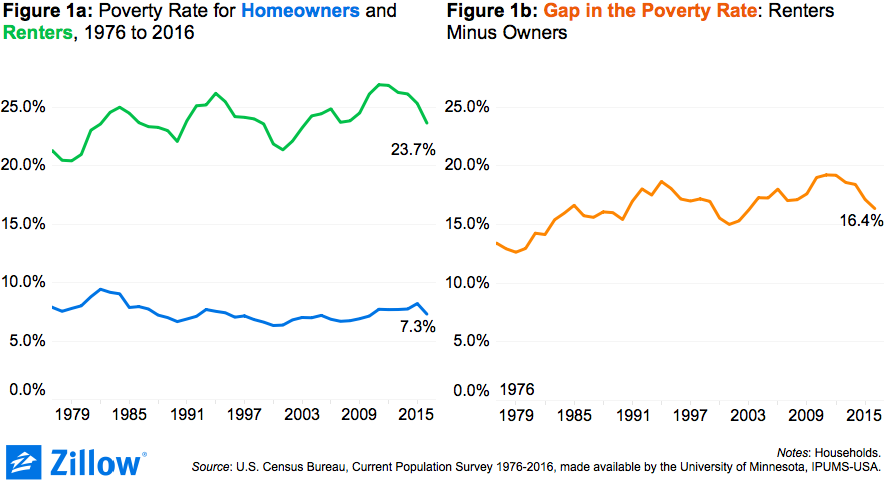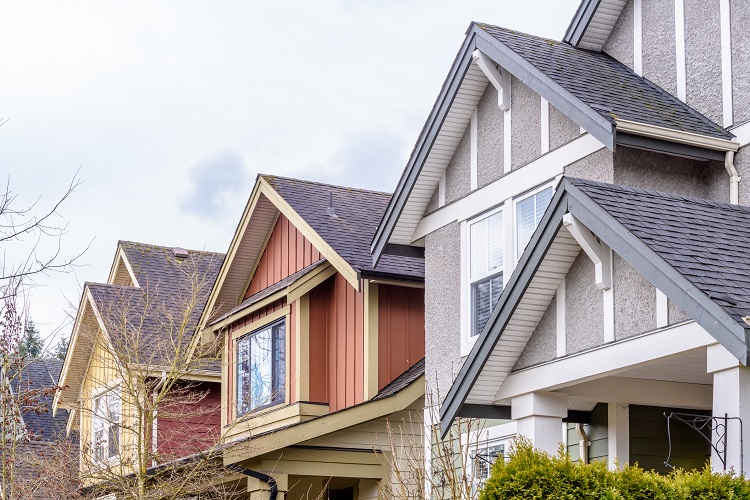The Structures of Poverty: Renter Poverty Rates Are Highest in Low-Density Multifamily Units
As the poverty rate among America’s homeowners has trended downward over the past four decades, it has steadily marched upward among renters. Poverty rates are highest among black renters and single parents, and in older, low-density multifamily rental units, which are often found in suburbs.
- The gap in the poverty rate between renters and homeowners has widened over the past four decades, worsening after economic downturns.
- More than two-thirds of poor American households rent, while more than two-thirds of households not in poverty own their homes.
- Poverty rates are highest among black renters and single parents, and in older, low-density multifamily rental units, which often are found in suburbs.
As the poverty rate among America’s homeowners has trended downward over the past four decades, it has steadily marched upward among renters. The result is a growing poverty gap between homeowners and renters (figures 1a and 1b).[1] By the early 2010s, about 65 percent of America’s poor households were renters, up from about 55 percent in the early 1980s. Today, renters are over two times more likely than homeowners to live in poverty.
Weaknesses in the American economy are major drivers of poverty, particularly among renters. Their poverty rate peaked at 25 percent in 1984, then 26.2 percent in 1994 and 26.9 percent in 2011 – all a year or two following the end of major economic downturns in the United States.
Homeowners also see poverty rates rise as the national economy contracts, though the response is more muted than among renters. During the Great Recession – from 2007 to 2012 – the poverty rate among renters jumped 3.2 percentage points to 26.9 percent, but increased only 1 percentage point to 7.7 percent among homeowners.[2]

Among renters, poverty is concentrated in certain housing types and demographic groups. Take, for example, poverty rates among renters living in structures of various sizes and ages (figure 2).
In general, poverty is most prevalent in lower-density multifamily developments – particularly in duplexes, triplexes and quads built in the 1960s and 1970s – and in large apartment buildings (those with 50 or more units) built prior to the 1960s. Low-density multifamily buildings are often located in the suburbs, where the renting poor have become more visible since the Great Recession, and in smaller, less economically dynamic cities. At the other extreme, the lowest poverty rates among renters are found in the newest large apartment buildings, and in single-family homes.
Of course, one reason poverty rates are higher in older units is because as homes age, they tend to become more affordable relative to pricier, newer units. Duplexes, triples and quads appear to be a general exception to this rule: Poverty rates in the newest duplex, triplex and quad rentals are just as high as in much older rentals.
However, because so many more Americans live in single-family homes than in other types of structures, renters of single-family homes are still the largest single group of poor renters. They represent 31.3 percent of all poor renter households, followed by renters in mid-sized multifamily structures (31.2 percent), renters of low-density multifamily units (19.8 percent), and renters of large multifamily buildings (11.3 percent).
Looking at poverty and rental structures through the lens of race, it’s important to remember that nationally, poverty rates among blacks and Hispanics – 24.8 percent and 22.2 percent, respectively – are more than double that of non-Hispanic whites (10.4 percent). (For Asians, it’s 13.2 percent.) Renters have higher levels of poverty overall, but the gap among races is narrower: The poverty rate for black renters is 34.1 percent, compared to 30.1 percent for Hispanics, 22.3 percent for Asians and 21.4 percent for non-Hispanic whites.
With the exception of Asians, the poverty rate is highest among renters living in low-density multifamily units (duplexes, triplexes and quads) (figure 3). Among blacks renting those units, the poverty rate is 32.5 percent, compared to 28.6 percent among black renters in single-family homes. Among non-Hispanic white renters, the poverty rate in low-density multifamily units is 22.2 percent, compared to 17.2 percent in single-family homes. Similarly, the poverty rate among Hispanic renters is 27.8 percent in low-density multifamily versus 23.6 percent in single-family homes.
Asians are the only racial/ethnic group to buck this trend. While Asian renters of single-family homes have the lowest poverty rates among Asian renters (18.3 percent), the highest poverty rate for Asian renters is found in large multifamily buildings (50 or more units). This suggests that poverty among Asian American communities is largely an urban phenomenon, whereas poverty among other racial and ethnic groups tends to be more suburban or focused on smaller cities.
Examining poverty rates by rental structure and family type, it’s important to know that poverty tends to be concentrated among single parents. Nationwide, the poverty rate among single parents is 42.5 percent, compared to 4.9 percent among married, childless adults – the group with the lowest poverty rate. Among renters, almost half of single parents (49.5 percent) are living in poverty versus 11.3 percent of married renters without children.
For all family types with children, the highest poverty rates are found in renters of low-density multifamily units (figure 4).
- For married families with children, the poverty rate in low-density multifamily rental units is 22.3 percent versus 14.8 percent for renters of single-family homes – the lowest for the group.
- For separated or divorced adults with children, the poverty rate in low-density multifamily rental units is 32.6 percent versus 24.7 percent for their peers living in large multifamily buildings – the lowest for the group.
- For widows and widowers with children, the poverty rate in low-density multifamily rental units is 25.8 percent versus 23 percent for their peers in single-family homes – the lowest for the group.
- For single parents, the poverty rate in low-density multifamily rental units is 51.5 percent versus 43.1 percent for their peers living in large multifamily buildings – the lowest for the group.
This pattern does not hold for childless households. Their highest poverty rates tend to be among renters in large multifamily buildings, although childless widows/widowers are an exception for whom rates are highest in low-density multifamily rental units.
Related:
[1] The poverty rates reported in this chart differ slightly from poverty rates reported elsewhere in this analysis, because the data are from the U.S. Census Bureau’s Current Population Survey rather than the American Community Survey.
[2] Of course, some of this is occurred as lower-income homeowners lost their homes to foreclosure and became renters.

